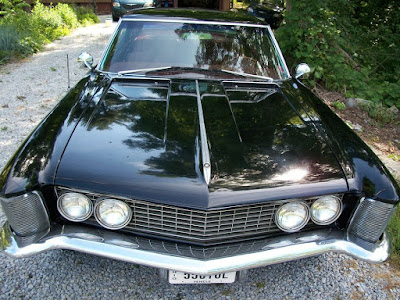Friday, July 30, 2021
1950 Oldsmobile 88 - Not a Cloud in the Sky
Wednesday, July 21, 2021
1956 Buick Special - It's Always Cloudy in Cleveland
The Buick Special was, historically, Buick's least expensive model and not surprisingly was most model years their best seller. Buick festooned "Special" to myriad other models as well but more so as a sub-brand as opposed to a distinct make. As if a badge of shame, Buick Special's of this vintage had three decorative venti-ports while all other Buick's had four.
1976 Buick LeSabre - Gas Pains
It's telling that some of the pictures I found on Facebook Marketplace of this 1976 Buick LeSabre are of it in a gas station. Gas prices have smashed through the $3.00 a gallon ceiling here in Northeast, Ohio recently and seeing this car has a twenty-seven and-a-half gallon tank, filling it up through the gas filler pipe behind the rear license plate is gonna cost the owner a small fortune.
My Wonder Years coincided when American's were still feeling the after effects of the October 1973 OPEC Oil Embargo. Shortages ended when the embargo ended in March of 1974 but prices for gas stayed at or near embargo-esque prices as part of the negotiations to get the oil spigots back; thus making a Yank-Tank like out '76 here a major household liability. Not that it wasn't before the embargo but with gas at fifty to sixty cents a gallon as opposed to a pre-embargo thirty or so, modest American's with an average household income of under $13,000 who drove gas guzzlers like this had one of two options; buckle down and pay the stiff tariff or opt for something smaller and more fuel efficient. Neither sounded like particularly alluring.
We know that shortly after General Motors rolled out their enormous 1971 full-size lineup that they had already begun work on downsizing their literal fleet but until they were ready, they scrambled to make their then current dinosaurs better on gas. Thanks to fuel injection, engine control systems, aerodynamics and automatic transmissions with myriad gears, nowadays it's not out of the ordinary for two-and-a-half-ton SUV's with four-hundred plus horsepower to get twenty or so miles to the gallon. Powered by a carbureted V-8 engine, a transmission with just three gears, a semi-aggressive axle ratio, nary a electronic engine controller and aerodynamics of a barn door, this LeSabre might get ten miles per gallon. On the highway with the A/C off and the engine in good tune. Six or seven miles per gallon turtle-ing around town if they stayed "off the gas". Suddenly four-cylinder Datsun's looked plenty alluring.
Even prior to the embargo the adage of a big American car with a powerful V-8 engine had already begun to wane. Auto manufacturers struggled to comply with federally mandated emissions standards and their crude methods greatly impeded vehicle performance. Steps to improve gas mileage only made things worse. To improve gas mileage, Buick advertised a new camshaft on their 350 and 455 engines, our big banana here has the 350, that reduced valve lift to reduce airflow to improve fuel economy. The 3.08 rear axle was scrapped for a 2.56 as well. If you ever driven a bone stock, big old American brute from this time period no doubt you'd think something was wrong with the engine. Nope. Just the convluence of emissions plumbing and gas saving gimmicks construing to make cars of the mid-'70's perform poorer than cars built in the 1940's. Buick was so desperate to improve fuel economy that they even offered their V-6 engine on 1976 LeSabre's.
The Great Downsizing Epoch that GM kicked off in 1977 chopped nearly a foot off of the LeSabre that replaced our dread-naught here, was upwards of three inches less wide, weighed roughly 800 pounds less and came with a standard 2.41 axle. Fuel economy was improved upon; instead of the obligatory ten miles gallon, a 1977 Buick LeSabre might get twelve to fifteen miles per gallon. Abysmal today but nothing short of clandestine back in the day.
Better gas mileage, better handling and more interior and trunk space than before? GM's 1977 full-size lineup was a watershed moment of automobile engineering and, subjectively less so design wise. They repeatedly stubbed their bumpers subsequently downsizing the rest of the wares but for a moment, all was right with the then largest corporation in the world.
As if my woe-begotten youth couldn't have gotten any worse, another gas crisis crushed the economy and driving habits of Americans again in the fall of 1979. If dinosaurs like our '76 LeSabre here weren't already chastised, that gas blitz that spiked the cost of a gallon of gas over a dollar-a-gallon reduced their resale values further still. Perhaps our '76 here was moth-balled then and just recently "un-barned"; if there is such a term. If there isn't, there should be. Yeah, "un-barned" just in time for another meteoric rise in gas prices. Somethings, I guess, never change.





































